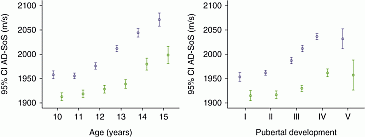ICCBH2013 Poster Presentations (1) (201 abstracts)
Impact of age and pubertal development on bone mass assessed by quantitative ultrasound of the proximal phalanges in boys and girls aged 10–14 years
Tathyane Krahenbuhl , Ezequiel Moreira Gonçalves , Vinicius Barbeta , Luiz Carlos Ramalho , Juan Samur-San Martin , Fabio Bertapelli , Roberto Regis Ribeiro , Antonio Azevedo Barros-Filho & Gil Guerra-Junior
University of Campinas (UNICAMP), Sao Paulo, Brazil.
The quantitative ultrasound (QUS) of the proximal phalanges has been used for the indirect evaluation of bone status. Furthermore, the relative simplicity and non-exposure to radiation, presents advantages for the use of QUS compared to other methods in children and adolescents. The aim of this study was to determine the influence of age and pubertal development on Amplitude Dependent Speed Sound (AD-SoS) assessed by QUS of proximal phalanges in girls and boys aged 10–15 years old. The QUS measurements were performed on 1892 Brazilian white students (1165 girls: weight=43.4±10.8 kg and height=152.7±10.1 cm, and 727 boys: weight=43.8±11.9 kg and height=152.0±11.8 cm) using the DBM Sonic BP device (IGEA, Carpi, Italy). The pubertal development was evaluated by self-assessment according to breast stage (I–V) for girls and pubic hair (I–V) for boys. Girls demonstrated significantly higher AD-SOS values (range 1808–2190 m/s) compared to boys (range 1976–2140 m/s), in all ages (Fig.1 left panel) and pubertal stages, as illustrated in Fig. 1 (right panel). This result is repeated when the groups were compared in relation to maturational stage, the same stage for girls presented higher values of Ad-SOS. The AD-SoS increased significantly from 11 to 14 years old (P<0.01) for girls and for boys the increase was significant from 13 to 14 years old (P<0.001). As for the pubertal development, a statistical difference were found between the stages II and IV for girls (P<0.001) and between stages III and IV for boys (P<0.001).

Figure 1 AD-SOS values for boys (green) and girls (blue) by age (left panel) and pubertal stage (right panel).
This sample of Brazilian children and adolescents, the values of AD-SoS of girls suffered greater influence of age and pubertal stage. It is suggested that more longitudinal studies are needed to confirm these results.




